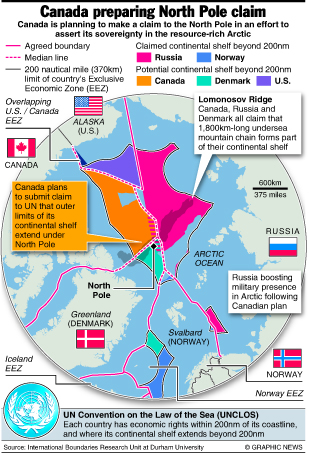Sunday Times 2
Canada’s audacious bid to own the Arctic
Canada has made a claim on the North Pole in an effort to assert its sovereignty in the resource-rich Arctic.
The country last week applied to extend the borders of its seabed in the Atlantic Ocean, including extensions into the Arctic seafloor covering roughly 656,000 miles (1.7 million sq km).
Canada filed the preliminary submission last week based on rules laid out in the UN Convention on the Law of the Sea, which regulates international law for the oceans.
If successful, the country will have rights to the polar region’s resources, which is estimated to contain 30 per cent of the world’s undiscovered natural gas and 15 per cent of oil.
While Canada’s Foreign Affairs Minister, John Baird announced that the country’s final claim would include the North Pole, he added scientific evidence to back the claim isn’t yet ready.
‘For whatever reason, the scientists and the aircraft stopped the research when they got to the Pole,’ Professor Robert Huebert, an Arctic expert at the University of Calgary told MailOnline.
‘The science couldn’t have been too hard, because they were able to get up to the Pole. But no one has given me a satisfactory answer as to why they stopped.’
‘It may just have been a simple mistake,’ he added.
Professor Huebert said further studies will depend on the availability of researchers, ice breakers and scientific equipment, but at a push, it could be completed in a year.
Canada’s decision to continue the work puts it head-to-head with Russia, along with potential negotiations with Denmark and the U.S., as all have expressed interest in the Pole.
Asserting Canada’s rights in the Arctic has been a popular domestic issue for Prime Minister Stephen Harper, though at least one expert on the issue described the planned claim as a long shot.
‘We are determined to ensure that all Canadians benefit from the tremendous resources that are to be found in Canada’s far north,’ Mr Baird said. Canada’s submission last week set out the potential outer limits of the country’s continental shelf in the Atlantic – a claim of 656,373 miles (roughly 1.7 million sq km).
Canada’s follow-up submission will include a claim to the Lomonosov Ridge, an undersea mountain range between Ellesmere Island, Canada’s most northern land mass, and Russia’s east Siberian coast.
That claim would extend Canada’s claim 200 nautical miles beyond the North Pole.
The submission that Canada filed with the UN is essentially a series of undersea co-ordinates that map what the government claims is the country’s extended continental shelf.
Mr Baird said it’s a mammoth task, and the government needs more time to complete the mapping in the Arctic, and to get its UN submission right.
‘That’s why we have asked our officials and scientists to do additional and necessary work to ensure that a submission for the full extent of the Continental Shelf in the Arctic includes Canada’s claim to the North Pole,’ he said.
The UN submission is also political, said Michael Byers, an expert on Arctic and international law at the University of British Columbia.
‘(Harper) does not want to be the prime minister seen publicly as having surrendered the North Pole, even if the scientific facts don’t support a Canadian claim,’ Professor Byers said.
‘What he’s essentially doing here is holding this place, standing up for Canadian sovereignty, while in private he knows full well that position is untenable.’
The UN submissions do not lead to a binding decision, but lay the groundwork for future country-to-country negotiations over competing territorial claims in the Arctic that could take years to resolve.
© Daily Mail, London


